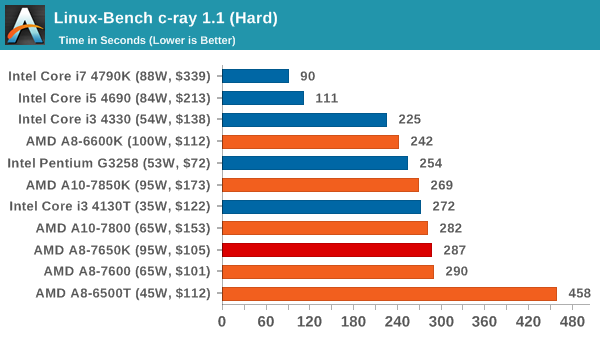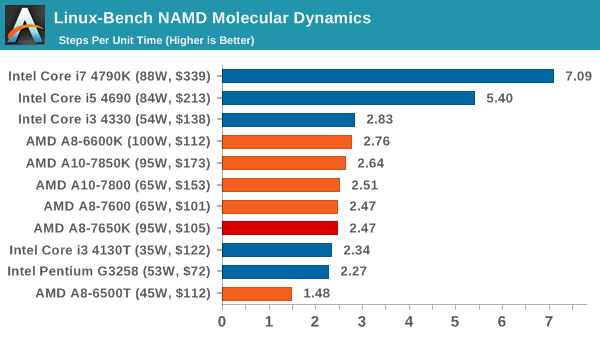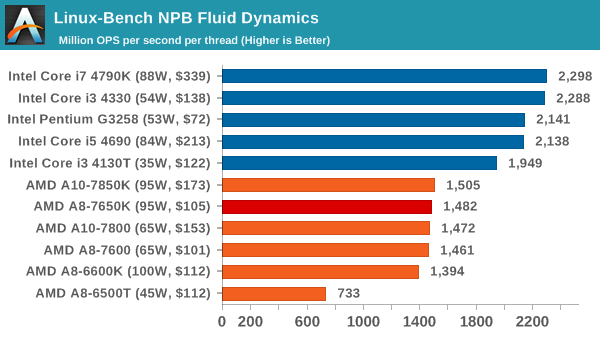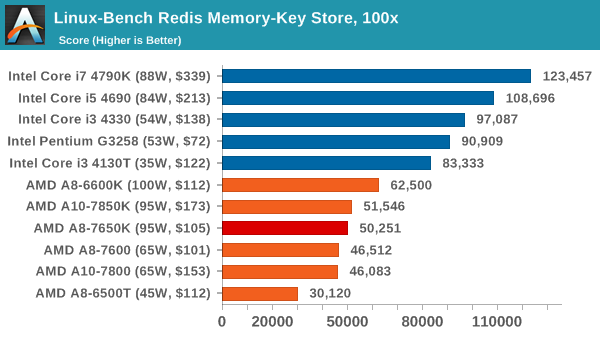The AMD A8-7650K APU Review, Also New Testing Methodology
by Ian Cutress on May 12, 2015 10:00 AM ESTProfessional Performance: Linux
Built around several freely available benchmarks for Linux, Linux-Bench is a project spearheaded by Patrick at ServeTheHome to streamline about a dozen of these tests in a single neat package run via a set of three commands using an Ubuntu 11.04 LiveCD. These tests include fluid dynamics used by NASA, ray-tracing, OpenSSL, molecular modeling, and a scalable data structure server for web deployments. We run Linux-Bench and have chosen to report a select few of the tests that rely on CPU and DRAM speed.
C-Ray: link
C-Ray is a simple ray-tracing program that focuses almost exclusively on processor performance rather than DRAM access. The test in Linux-Bench renders a heavy complex scene offering a large scalable scenario.

Being a scaling benchmark, C-Ray prefers threads and seems more designed for Intel.
NAMD, Scalable Molecular Dynamics: link
Developed by the Theoretical and Computational Biophysics Group at the University of Illinois at Urbana-Champaign, NAMD is a set of parallel molecular dynamics codes for extreme parallelization up to and beyond 200,000 cores. The reference paper detailing NAMD has over 4000 citations, and our testing runs a small simulation where the calculation steps per unit time is the output vector.

NAMD is similar to our office benchmarks, puttin the bulk of the APUs between the i3-4130T and the i3-4330.
NPB, Fluid Dynamics: link
Aside from LINPACK, there are many other ways to benchmark supercomputers in terms of how effective they are for various types of mathematical processes. The NAS Parallel Benchmarks (NPB) are a set of small programs originally designed for NASA to test their supercomputers in terms of fluid dynamics simulations, useful for airflow reactions and design.

Despite the rated memory on the APUs being faster, NPB seems to require more IPC than DRAM speed.
Redis: link
Many of the online applications rely on key-value caches and data structure servers to operate. Redis is an open-source, scalable web technology with a b developer base, but also relies heavily on memory bandwidth as well as CPU performance.











177 Comments
View All Comments
evolucion8 - Wednesday, May 13, 2015 - link
Actually the R9 280/280X have a 384-Bit BUS and their memory is clocked higher. That is why they offer around 288GB/s for it alone while the PS4 has 176GB/s shared for the system including RAM/BUS/CPU/GPU operations.Edens_Remorse - Wednesday, May 27, 2015 - link
/slow clapevolucion8 - Friday, October 16, 2015 - link
280/280X actually has a 384-Bit BUS.DevilSlayerWizard - Wednesday, May 13, 2015 - link
Every one of those 8 cores are a big joke compared to even Nehalem.silverblue - Wednesday, May 13, 2015 - link
...and this says you're telling porkies, for the most part:http://anandtech.com/bench/product/697?vs=47
Changed the 47 to a 100 for the 950, and to 45 for the 965 Extreme. Remember that these are 8-thread, triple channel CPUs.
nikaldro - Thursday, May 14, 2015 - link
Mmmm hellooooo? You actually believe that 8 Jaguar cores can even remotely be compared to any decent desktop class cpu?Kraelic - Thursday, May 14, 2015 - link
Those older generation discontinued Intel at 3 GHz trade blows with a current 4GHz AMD. Do you not get the joke?redraider89 - Tuesday, May 19, 2015 - link
That's not what he said. Who knows what he means. AMD's comment about what? Poached eggs? Like I said, stupid.yannigr2 - Tuesday, May 12, 2015 - link
56 comments.yannigr2 - Wednesday, May 13, 2015 - link
108 comments.